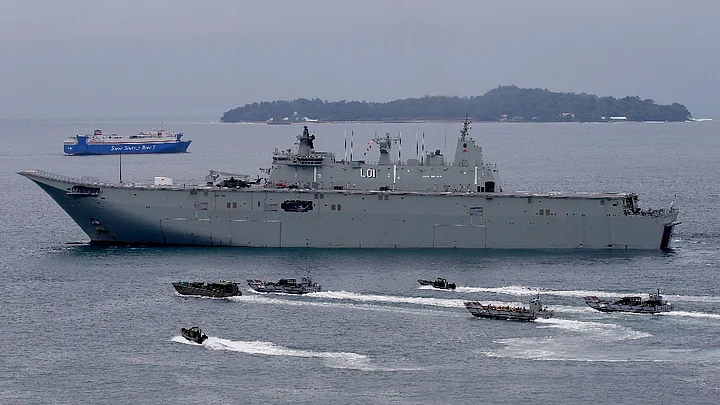China's military says it has boosted the capabilities of the navy's South China Sea fleet, with the addition of a salvage and rescue squadron equipped with boats and divers.
Chinese vessels operating in the 3.5 million-square-kilometer (1.35 million-square-mile) sea had formerly been forced to rely on a salvage and rescue squadron based in northern China to deal with accidents. The official Global Times newspaper reported last week that the unit will be equipped with rescue craft and equipment, along with divers to "minimise losses in accidents and protect marine engineers."
It said the squadron could also be deployed for other purposes, including for emergency rescues on land.
The People's Liberation Army navy's mission area "has been expanding, so it was almost impossible for it to command only one such rescue team to provide a speedy response, the paper quoted an anonymous military expert as saying.
The South China Sea Fleet "has convenient access to both the Pacific Ocean and the Indian Ocean, and this new squadron can greatly increase its defense ability along the coastal area and at sea, as well as in combat," it quoted the expert as saying.
Tillerson Criticises China's Island Building in South China Sea
US Secretary of State Rex Tillerson criticised China over its island building and expansive territorial claims in the South China Sea in a speech to an American think tank.
Drawing a contrast with India, with whom the US has an increasingly close security relationship, Tillerson said China had “at times” undermined the rules and standards of international engagement.
"China's provocative actions in the South China Sea directly challenge the international law and norms that the United States and India both stand for," Tillerson said in an address at the Center for Strategic and International Studies in Washington.
Tillerson said the US seeks constructive relations with China, but "won't shrink" from the challenges it poses when it "subverts the sovereignty of neighboring countries, and disadvantages the U. and our friends."
In an interview with the Wall Street Journal, Tillerson also said China "went too far" in pushing to claim resources in the South China Sea.
"Our view is you're going to have to walk some of that back," he said, while also expressing US support for a code of conduct in the region that China is negotiating with the Association of Southeast Asian Nations.
The Chinese Embassy in Washington issued a statement calling the situation in the region “generally stable”.
"Countries outside the region should fully respect these efforts to safeguard regional peace and stability," it said.
Chinese President Xi Praises South China Sea Island Construction
Chinese President Xi Jinping praised China's controversial island-building project in the South China Sea in his address to the ruling Communist Party's national congress, an event held every five years.
"Construction on islands and reefs in the South China Sea has seen steady progress," Xi said. The comments came in an introductory passage on "major achievements in economic development" and did not explicitly address the islands' military purposes or advantages.
Elsewhere in the three-and-a-half-hour address, Xi devoted considerable attention to the importance of maintaining a military that is "built to fight," and pledged "solid steps to ensure military preparedness for all strategic directions, and make progress in combat readiness in both traditional and new security fields."
On foreign policy, Xi issued a somewhat conflicting message, seeking to reassure foreign countries that China would “never pursue development at the expense of others’ interests,” while adding that China will never “give up its legitimate rights and interests.”
"No one should expect China to swallow anything that undermines its interests," Xi said.
The US says China has reclaimed more than 1,295 hectares (3,200 acres) of land in the South China Sea by piling sand and concrete on top of coral reefs, equipping some with air strips and military installations.
Philippines, Australia Stage Joint Disaster Response Drills
Filipino and Australian naval forces held joint disaster response drills in Subic Bay facing onto the South China Sea, pointing to their deepening security ties in a region prone to calamities, piracy and territorial rifts.
Lt Col Daniel Turner of the Australian Defence Force said the exercises would strengthen the two countries' ability to jointly respond to typhoons and other disasters when roads, bridges, and ports are damaged or destroyed.
The drills reflect the strengthening security relations between the two US allies, despite Philippine President Rodrigo Duterte’s often antagonistic stance toward American security policy.
During the maneuvers, more than 100 Philippine marines and Australian naval personnel took off from an Australian navy ship on board troop carriers, then rushed to a port at Subic Bay, a former US naval base.
Australia signed a 2007 accord that allows its forces to train in the Philippines. Australia is the only country aside from the United States with which Manila has forged such a defense pact.
(Breathe In, Breathe Out: Are you finding it tough to breathe polluted air? Join hands with FIT to find #PollutionKaSolution. Send in your suggestions to fit@thequint.com or WhatsApp @ +919999008335)
(At The Quint, we question everything. Play an active role in shaping our journalism by becoming a member today.)
